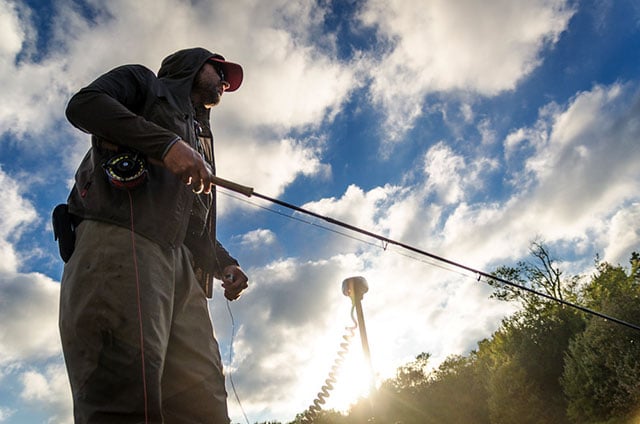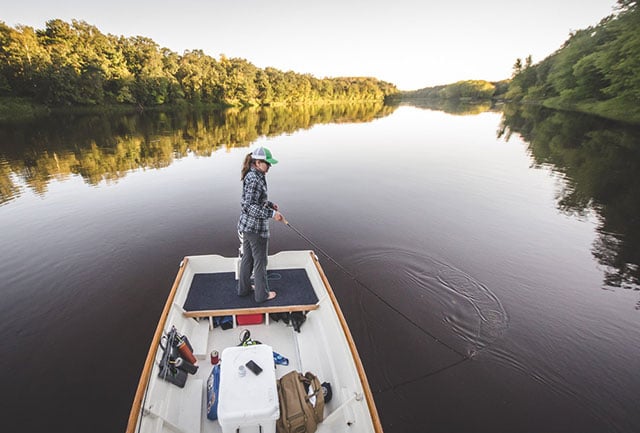A Musky Fly Fishing Starter Kit
 Over the last few years, we’ve fished with and interrogated some of the top fly-rod musky experts, and here we’ve distilled their rigging down to some smooth-sipping starting points. These are the essential pieces of kit that will get you on the water, safely, so you can begin grinding away at your ten thousand casts.
Over the last few years, we’ve fished with and interrogated some of the top fly-rod musky experts, and here we’ve distilled their rigging down to some smooth-sipping starting points. These are the essential pieces of kit that will get you on the water, safely, so you can begin grinding away at your ten thousand casts.
We know you want to talk about the rod first. It’s the sexiest component of any new setup. But we’re going to work backwards, because everything that’s different about musky gear is different for one reason: to empower you to cast giant, heavy flies.
The Flies
Buy your first half-dozen musky flies. Tying them is fun, but there’s a lot more to it than “hair, feather, flash,” and it takes practice. Most of us have boxes full of B-team flies that don’t swim just right or are threadbare after being chomped by hammer-handle pike. This trial and error period can waste lots of hours and expensive materials. Not that you should never tie your own musky flies, but stack the deck in your favor and spend some time fishing with and studying pro-tied flies first.
What size? The real question is “how much fly can I cast?” In the words of O.G. musky guru Lucky Porter: “Even little ones will whack big shit, and big ones might need it to get their attention.” Ten to 12 inches is standard. Six flies will last you a season—you’ll probably end up fishing the same two or three favorites most of the time. Start with black and yellow, black and orange/red, black and chartreuse/orange (“firetiger”), and all black. To round out the palette, toss in an extra-large tan and cream sucker pattern.
There are a lot folks out there selling musky flies these days—some are proven, some are not. Vet carefully and don’t go cheap. Ties from veteran musky feeder Brian Bergeson can be counted upon. When you place your order, tell him where you’re fishing and he can tailor the patterns to your local forage and water. Also proven are the bigger musky offerings from Eli Berant. Look at his “Optimus Swine” and “B1G Foosa.”
Pro tip: flatten the barbs on all your hooks religiously. It’s not just better for the fish, but it’s also much safer for you—both when casting in the wind and when extracting from large, furious fish. When you want those hooks out, you want them to come out fast and easy.
The Leader
The formula: about three feet of stiff, heavy monofilament, and 12-18 inches of bite tippet. It sounds short, but it turns over big flies easy and makes figure-eights smooth.

Scientific Anglers recently released a line of pre-rigged toothy-fish leaders, and the Figure 8s are just right for musky fishing. They’re not cheap, but they’re hand-made in Michigan with premium components and will get you on the water with confidence and no knot-tying required.
Stick with wire for bite tippet. Fluorocarbon is expensive, bite-resistant but not bite-proof, and offers few advantages over wire under most conditions. A bite-off is a lost fly, a lost fish—maybe the fish of your life—and maybe even a dead fish. Just use wire. Our favorite is American Fishing Wire Surflon 7×7 nylon-coated stainless steel wire, in 40-pound test, camo brown. It’s soft and knots well, resists kinking and abrasion, and doesn’t rust. A single small spool will last a season or two.
Here’s a one-knot wonder-rig we learned from Wisconsin musky guide Chris Willen that allows you to loop-to-loop your pre-rigged flies to your leader in seconds:
- Tie a perfection loop on one end of 18 inches of your bite tippet wire.
- Tie your fly onto the other end with another perfection loop.
- Loop (or nail knot) three feet of 40-50 pound mono to your fly line.
- On the end of that, tie a two-inch wide perfection loop.
- Pass the big mono loop through the small wire loop, then pass the fly through the big mono loop.
It’s not the cleanest solution—lots of loops in your leader and wire in your fly box—but it’s reliable, easy to rig on the water, and cost-effective.
Pro tip for tightening perfection loops in stiff mono and wire: moisten all knots, and use the rounded end of your forceps/pliers as a T-handle through the loop.
The Line
You need an authoritative sinking-head streamer line. For now, forget the floaters and intermediates. The Scientific Anglers Sonar Sink 25 Cold is our favorite for most conditions—400 grains for a 10-weight or 450 grains for an 11-weight. It has a 25-foot sinking head that shoots after one false cast, turns over big flies with a cathartic “plop,” and keeps them 3-5 feet below the surface, right in the kill zone. Its braided core won’t coil up in the cold, and the running line is easy to manage even with stiff October fingers.
Pro tip: swallow your pride and get some of those spandex stripping guards. Cold and wet plus all-day streamer fishing equals raw fingers.
The Rod
A 10-weight is the minimum, and an 11 will toss bigger flies but is harder to find on the shelf. It doesn’t have to be expensive—in fact, the slower action of an entry-level rod can actually help ease the learning curve a bit. Casting a big fly and a heavy sinking line takes practice, and not the kind you can do on the lawn, so a softer rod can be more forgiving as you develop your own big-meat casting stroke.
The Orvis Clearwater and TFO BVK are both good affordable starter rods, though they are only available in 10-weight. The TFO Esox and Redington Predator Musky are both good 11-weight starters. If you want to jump right into a top-end musky stick, check out the one-piece Orvis H2 11-weight or the Clutch Tannik 450—either is an all-day laser beam with a 450-grain line, if you are on your game. If not, these super-fast actions can punish you.
 No matter what you get, make sure you send in your warranty card, because figure-eights in rocky rivers are tough on rod tips.
No matter what you get, make sure you send in your warranty card, because figure-eights in rocky rivers are tough on rod tips.
Pro tip: don’t go right from a 5-weight to a 10-weight. Spend some time with your 8-weight and a sinking line between trout season and musky season—this will help prevent chronic tendon and joint injuries. Not kidding.
The Reel
The old axiom “the reel is just there to hold your line” is especially true in musky fishing. They’re not runners, they’re fighters. You don’t need a high-end drag or an ultra-wide arbor. That said, you do want a forget-about-it reliable reel that can take the abuse of boat life without bending a rim or pinching your line, and that has enough heft to balance your heavy-duty rod. The Ross Reels CLA 6 was a standby, but they don’t make it any more—you might look at its successor, the Cimmaron II 9/10.
Pro tip: check your reel seat tightness throughout the day. This kind of casting has a tendency to loosen things up more than, say, trout fishing, and a reel this big clunking on the boat deck—or your toes—is bound to break something.
The Tools
Forget about nippers: you need to cut wire and crush 6/0 hook barbs. Heavy-duty forceps like these from Montana Fly Co. work great, but don’t expect the cutter portion to last forever. Workable options are at the hardware store for a few bucks. While there, get a really long set of bent-tip needlenose pliers.
The pliers are for deep fly recovery, and for this you’ll also want a wire mouth spreader, unless you enjoy lacerations that bleed for hours. For really bad situations, a small bolt-cutter type tool can be used to cut hooks to save a fish or yourself from severe injury. But resist the temptation to get a Boga or other mechanical lip-grip: they can damage the musky’s relatively slender lower jaw far too easily. Google image search if you’re skeptical. It’s ugly.
What really makes releasing muskies successful and safe for all parties is a big friendly net. Giant four-foot-deep musky nets are the standard in gear-fishing circles, but most of them are designed for giant boats with lots of storage. There are folding options, like the Stowmaster TS94IM, and they work very well. But they’re still very big, and very costly. Luckily for us, barbless two-hook flies are much easier and safer to extract than giant lures with two or three barbed trebles, so having a giant musky-specific super-net is not critical—but you still do need a solution that works in your boat and your budget. Make sure it is big enough to hold a four-foot fish and has small, slime-friendly netting that won’t split your new best friend’s fins.
Pro tip: put a lanyard on anything critical, and carry extras of cheap tools. You’ll be working on fish over the water and cold fingers drop tools.
Now What?
So you’ve got the gear now. Where to start? A day on the water with a musky guide. This kind of fishing is different enough from anything else in fresh water that you’ll enjoy a major jump-start by paying a pro for a day. You’ll pick up a fistfull of cheat codes about how muskies think and act and eat and how to handle them when hooked and when in the net — and you’ll have someone reminding you to figure-eight after every cast and yelling at you when you trout set.











